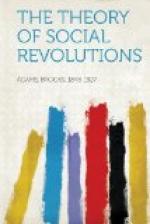Nearly a century ago, Jefferson wrote to Spencer Roane, “The Constitution, on this hypothesis, is a mere thing of wax in the hands of the judiciary, which they may twist and shape into any form they please."[39] And however much we may recoil from admitting Jefferson’s conclusion to be true, it none the less remains the fact that it has proved itself to be true, and that the people have recognized it to be true, and have taken measures to protect themselves by bringing the judiciary under the same degree of control which they enforce on other legislators. The progression has been steady and uniform, each advance toward an assumption of the legislative function by the judiciary having been counterbalanced by a corresponding extension of authority over the courts by the people. First came the protest against Marbury and Madison in the impeachment of Chase, because, as Giles explained, if judges were to annul laws, the dominant party must have on the bench judges they could trust. Next the Supreme Court of New York imagined the theory of the Police Power, which was adopted by the Supreme Court of the United States in 1837. But it stood to reason that if judges were to suspend constitutional limitations according to their notions of reasonableness, the people must have the means of securing judges whose views touching reasonableness coincided with their own. And behold, within ten years, by the constitution of 1846, New York adopted an elective judiciary.
Then followed the Dred Scott Case, the Civil War, and the attack on legislative authority in Hepburn v. Griswold. Straightway the Court received an admonition which it remembered for a generation. Somewhat forgetful of this, on May 15, 1911, Chief Justice White gave his opinion in the Standard Oil Case, which followed hard upon a number of state decisions intended to override legislation upon several burning social issues. Forthwith, in 1912, the proposition to submit all decisions involving a question of constitutional law to a popular vote became an issue in a presidential election. Only one step farther could be taken, and that we see being taken all about us. Experience has shown, in New York and elsewhere, that an election, even for a somewhat short term, does not bring the judge so immediately under popular control that decisions objectionable to the majority may not be made. Hence the recall. The degradation of the judicial function can, in theory at least, go no farther. Thus the state courts may be said already to be prostrate, or likely shortly to become prostrate. The United States courts alone remain, and, should there be a struggle between them and Congress, the result can hardly be doubted. An event has recently occurred abroad which we may do well to ponder.




